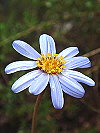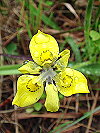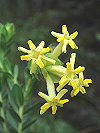






| Flora of Southern Africa | Eastern Cape Photo Gallery 2008 |
Western Cape Photo Gallery 2010 | Western Cape Photo Gallery 2012 |
 |
 |
 |
 |
 |
 |
 |
Photo identifications L-R: Felicia aethiopica, Drosera trinervia, Moraea papilionacea, Adenandra uniflora, Gnidia oppositifolia, Erica conica, Lobelia coronopifolia. |
| The Eponym Dictionary of Southern African Plants |
| Plant Names A-B | Plant Names C-F | Plant Names G-K |
| Plant Names L-O | Plant Names P-S | Plant Names T-Z |
| References | Questions and Uncertainties |
This website has been a labor of love for me over the past eight years, and one which has benefitted from the assistance of many other people and many sources both print and online. It began after I had created a website called California Plant Names: Latin and Greek Meanings and Derivations, and grew out of an intense interest in the scientific names of plants, what they meant, where they came from, who created them, and whom did they commemorate. I started by jotting down notes about various epithets, and gradually accumulated more and more information until I had a dictionary which included almost all of the generic and specific names of California plants. At the same time, my interest in southern African plants had been engendered by a trip there in 1998, with follow-up visits in 2008, 2010 and 2012. The two regions (particularly California and the Western Cape) are connected by sharing a Mediterranean climate regime of long hot summers and cooler, rainy winters. I decided that I would do something similar to my California names site, but concentrating on the plants of southern Africa, and especially on those names that commemorate specific individuals, the botanists, pharmacists, plant collectors, farmers and other interested and interesting people whose memories deserve to be known and recalled, whether they are still living today or have been gone for hundreds of years. I began with the Plants of Southern Africa Checklist, maintained by the South African National Biodiversity Institute (SANBI), both online and in a print form published in the journal Stelitzia by Gerrit Germishuizen and Nicole L. Meyer. Quoting from the abstract, "Southern Africa has the richest temperate flora in the world and encompasses a rich floristic diversity of approximately 24,000 taxa (species and infraspecific taxa) of 368 families, including more than 10% of the world's vascular plant flora on less than 2.5% of the earth's land surface area." Southern Africa includes South Africa, Namibia, Botswana, Swaziland and Lesotho, but most of the taxa included in this compilation are present in South Africa proper. As botanists and plant collectors became increasingly familiar with the flora there, many plant species names were published which have since become obsolete for various taxonomic reasons. Including all of the synonymized names, the POSA checklist includes some 60,000 epithets, which I went through to extract those that I thought honored specific people. This is not as easy as it might seem. Epithets derived from people's names when Latinized are not always recognizable as such. Further, a name can be a person's name or the name of a geographic location. So I undoubtedly may have missed some names, but they can be added at such time as they are so recognized, and I invite anybody to notify me of any omissions that they may become aware of. The process of investigating these epithets is very much like detective work, where one source gives a clue which leads to another source, and another clue, and so on. In many cases these clues are contradictory and confusing, and lead in a useless direction. Often times they are embedded in some foreign website or publication and have to be searched for in an awkward and frequently incomprehensible Google translation. At least some of my entries reflect this process of accepting or rejecting various conflicting information, and I think this is something about this website that is unique. It is perhaps surprising that long before this some botanical authorities or institutions would not have endeavored to create a record of exactly who every taxon commemorating a specific individual was named for. It seems to me that this should be a part of the public record for every so-named taxon, but it isn't. In many cases, one has to go back to the original publication, often one or two hundred years old or older, usually in a language that is not English, and housed in some library far away, and even then the plant name authors don't always say who they intended to honor. In some cases there are several people with the same last name, and it is not always easy to determine which one is correct. A certain amount of guesswork was involved in some of these entries, and I have tried to indicate where there is uncertainty. When a taxon has a person's name attached as a specific epithet and there is a specimen record of that taxon being collected by a person with the same name, I have made the assumption that this is the derivation of the epithet. This may not in every case be valid. I do not wish for anyone to be under the impression that I am an authority. This website is merely a compilation of information that is as available to anyone else as it is to me, although in many cases it has involved a lot of digging, following up on tenuous clues, and contacting botanists and botanical institutions who have almost invariably been helpful. Most of my sources are secondary ones, either published material, or other websites. Any of these sources can include incorrect information, and it is for this reason that I cannot and do not guarantee the accuracy of the material presented here, although I have done what I can to assure it. I am certain that there are mistakes in this etymological compilation, and when such have been brought to my attention I make every attempt to right them. It is an ongoing process, and one advantage of websites over books is that they can be continually and easily updated with new or additional facts. Anyone with any information at all which can supplement or correct that which is presented here is invited to please contact me at mmlcharters[at]calflora.net. Southern Africa includes South Africa, Namibia, Botswana, Swaziland and Lesotho, but most of these taxa are present in South Africa proper. Not all entries have been identified as to source, but some that are are from Umberto Quattrocchi's excellent 4-volume work CRC World Dictionary of Plant Names and his CRC World Dictionary of Grasses, for which I thank him greatly, Clifford and Bostock's amazingly complete Etymological Dictionary of Grasses, the PlantzAfrica website, and from Elsa Pooley's guides Mountain Flowers and Wildflowers of KwaZulu-Natal. I also want to express my very great appreciation and gratitude to my fellow southern Californian David Hollombe who has applied the same expertise that has improved my California Plant Names website to this one. His ability to track down obscure names is in my opinion unequalled, and his willingness to help has never failed me. Three other people to whom I am deeply indebted are Professor Leonard Newton, the co-author with Urs Eggli of the superb volume Etymological Dictionary of Succulent Plant Names (2004), who very kindly took time to go over the names of succulents in this compilation and wrote to me from Kenya with many valuable additions and corrections, Dr. Ted Oliver, "the Father of South African Ericas," who has generously provided much interesting information regarding the derivations of Erica names, and my very good friend Hugh Clarke, co-author with Deon Kesting of Botanical Names: What Do They Mean (2008), who very graciously corresponded from South Africa with many additional notes and information, and with whom I have spent a very enjoyable and educational two days on Table Mountain in 2010 and another day on the Gifberg above Van Rhynsdorp in 2012. Both Mssrs. Newton and Clarke share my interest in eponymy and have continued to be sources that I rely on. An absolutely invaluable source of information is Mary Gunn & Leslie Edward Wastell Codd's classic Botanical Exploration of Southern Africa (1981) and also their "Additional Biographical Notes on Plant Collectors in Southern Africa" (Bothalia 15, 1985). Other useful online sources are the Flora of Zimbabwe and the Swaziland Flora Database websites. I have also benefitted from the work of Geoffrey Andrew, retired solicitor from Hermanus, who has compiled the excellent Fernkloof Plant Names Explained. Taxonomic information has been drawn largely from the Plants of Southern Africa Checklist website created by the National Biodiversity Institute, the Tropicos website created by the Missouri Botanical Garden, the International Plant Names Index which is a joint project of the Harvard University Herbarium, Kew Gardens, and the Australian National Herbarium, JSTOR Plant Science, the African Plants Database, The Plant List which is a joint project of the Royal Botanic Gardens, Kew and Missouri Botanical Garden, and the Harvard University Herbaria index of botanists. I extend my sincere gratitude to Alice Notten, Interpretation Officer at Kirstenbosch National Botanical Garden in Cape Town, who has graciously tolerated my requests for information and helped to uncover the derivations of several difficult generic names. Finally, I thank the many botanical professionals I have contacted with questions regarding a single epithet, and I hope my efforts meet with their approval. NOTE: The list of epithets that makes up this compilation includes both ones that are current and ones that are no longer current. I feel it is important to remember and honor those individuals who have contributed to southern African flora even if the epithets that honored them have been overtaken by taxonomic changes and relegated to synonymy. There are still many names about which I have no information, and further research may illuminate some of these questions. It is my sincere hope that knowledgeable readers will weigh in with information that has escaped me. When I finish with the names I am fairly certain of, I will go back and try to do additional work on the questionable ones which are listed here. All photographs are by Michael Charters. |
 |
 |
| The Eponym Dictionary of Southern African Plants © 2006-2021 Michael L. Charters, Sierra Madre, CA. |